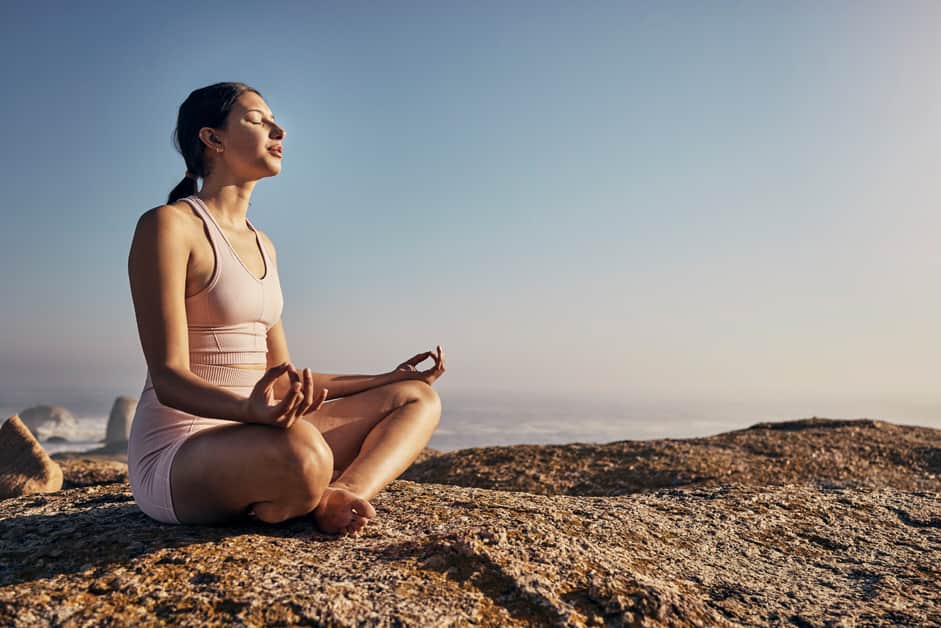Introduction to Lotus Pose
Lotus Pose, or Padmasana, has a deep history. It is known for its calming and meditative effects. It helps improve knee mobility. Plus, it’s beneficial for the hips and spine.
To do it safely and effectively, it’s important to slowly build up to this pose. It may be difficult to do at first. Let’s take a look into how to do it.
Benefits of Lotus Pose
Lotus Pose, also known as Padmasana, is a seated meditation posture. It helps open the hips and improve knee flexibility. It’s great for both beginners and experienced practitioners.
The main benefit of Lotus Pose is improved joint mobility in the hips and knees. This allows better alignment in the lower body muscles and structures. It can also help with stiff necks, back aches, shoulder pain, headaches and migraines.
Lotus Pose has other benefits too:
- It reduces the risk of injury.
- It boosts circulation and calms stress levels.
- It creates feelings of serenity and love.
- It improves posture, optimizes digestion and releases tension from the shoulders.
- It increases mental clarity, concentration and calms the nervous system.
What You Need to Know Before You Start
Lotus pose is a famed yoga posture. It aids in opening hips, bettering knee flexibility, and elongating the spine. It also gives a feeling of stability and broadening. Allowing practitioners to find repose, balance, and restorative energy.
But, there are various levels of difficulty with the posture. So, newbies should be aware. Start with warm-up moves like Cat/Cow Pose or Sun Salutations to get blood circulating. Then do preparatory poses like Half Lotus Pose or Bharadvaja’s Twist. These will help stretch the legs and lower body for the full Lotus pose.
Experienced yogis can start with a comfortable seated position in Staff Pose (Dandasana). Then modify until both legs are in lotus binds if possible.
When practicing this tough posture, focus on full-body engagement. Move slowly and steadily with mindfulness. Do not force yourself into the position by stretching just your legs. Also, don’t push too deep. Keep building on each cycle without compromising stability or being overly forceful. This can lead to injury rather than improvement.
Getting Into Position
Lotus Pose (Padmasana) is great for knee mobility and strength. But first, you must understand the correct position. This is essential for getting the full benefit. Here’s how to get into the pose:
Sitting and Stabilizing the Core
The Lotus Pose needs great flexibility in your hips and knees, as well as a stable spine and core. Sit cross-legged on your yoga mat. Your spine should be straight. Put your palms on your thighs or across your shins.
Draw in your belly to your spine to engage your core muscles and support your low back. If this is hard, focus on stretching up through the top of your head. Then, let your shoulders drop away from your ears. You will sense open pressure in your abs.
Take both hands and cup one ankle. Push down with both hands and stretch the foot. Wrap it around or below the opposite thigh. It should be tucked up onto its thigh. Keep pressing equally with both hands and secure it against the other thigh. Inhale before any more movement. In case of trouble, take a few breaths while stretching each hand separately. Then, try cupping both hands around each ankle together.
Placing the Feet in Lotus Pose
Start the lotus pose by sitting on the floor cross-legged. Keep your back straight and put your hands on your knees. Lift one foot up and place it onto the opposite thigh near the knee. Adjust your position if necessary to gain balance.
Raise the other leg and try to put it on the opposite thigh. Make sure to hold your chest tall and tuck your chin slightly. Relax your shoulders away from your ears. Remain in this full pose for a few breaths. This will give strength and flexibility to your entire body.
Aligning the Knees
When doing the Lotus Pose, the main focus is knee alignment. Ensure your outer thigh stays firmly on the floor or mat and that both pressure points are equal.
- Sit with both legs extended. Then, cross your right ankle over your left thigh. Make sure your inner arches touch each other and the top of the union is just above one knee joint. Move closer to your hips.
- Then, adjust the feet until the right ankle is directly on the left thigh and vice versa. You should feel connected at the point where both ankles meet, but still spread open between the hips and feet.
- Check for an even amount of padding beneath each knee. Add extra padding if needed.
Modifications
The Lotus Pose (Padmasana) is typically to increase knee flexibility. However, modifications are best for the beginner. Here, we’ll discuss body placement for the right alignment. Modifications can make it easier, if needed. Comfort and accessibility are key!
Using a Strap
Guitarists need straps. They’re useful for the right height when standing and for moving around on stage. Select a strong strap with padding for comfort. Adjustment is essential – over-the-shoulder and above-the-waist designs work. Look for extras like string pockets or pick holders.
For a unique look, try patches or other embellishments – many companies offer these options.
Using a Bolster
If you have limited mobility in your knees, hips, or ankles, consider using a bolster while practicing the Lotus position. It’s a long, cylindrical cushion you place on the mat near your hips. It gives more space and engagement for the hips and cushion to the lower back and spine.
- Sit with legs straight out in front, arms by your sides and torso lifted. Place a bolster parallel to your legs on the mat.
- Bend your right knee and slide your right foot onto the bolster, then your left foot onto the top of the calf muscle.
- Squaring the hips, press into feet and sit up tall. Engage core muscles and draw knees down to the floor towards the outer hip creases.
- Inhale and hold for 6-8 breaths, then switch legs. Inhale and press into feet, draw sit bones towards the sky and keep shoulders relaxed.
- Exhale slowly as you lift off from bolsters and fully extend legs. Pause and breath. Readjust as necessary when finished.
Using a Wall
Wall panels can be very useful when customizing your car. They are much stronger than other sheet metal materials, giving you more confidence when making modifications. Furthermore, they provide more options for customization as they can form molds and designs that other materials cannot. Additionally, they create an airtight seal, leading to superior noise dampening and thermal insulation.
Wall panels come in a variety of colors and finishes, so you can customize your car based on aesthetics or performance. Lastly, they offer greater strength, flexibility and protection from the elements. This makes them ideal for any projects that involve modifications or customizations.
Benefits of Lotus Pose
Lotus Pose is awesome for bettering knee mobility! It’s known for reducing knee pain when running or walking. Plus, Lotus Pose can help with posture, balance, focus, and relaxation.
This guide discusses the benefits of this yoga pose, plus how to get into it safely.
Improved Knee Mobility
Lotus Pose is a classic yoga position. It can help strengthen muscles near the hip, knee and ankle. It stretches the hips and ankles while strengthening the legs, buttocks, and spine. Practising it regularly can give better mobility to the knees. This means activities like squats and lunges are easier as the body can move through a full range of motion.
When practising Lotus Pose, make sure you have proper alignment for best results and to avoid injury. Sit with your back straight and legs crossed, one ankle on each thigh. Apply downward pressure and breathe deeply into the pose. This helps maintain hip alignment and so tension is not put on lower back or knees.
Comfortably in the pose, use muscle engagement. Like pressing out against inner thighs or squeezing knees together. Hold the pose for up to 5 minutes or until there is muscular relief around hips and knees. This can help with other yoga postures like Chair or Warrior I & II.
Improved Hip Mobility
Lotus Pose is a seated yoga posture with many benefits. It stretches your hips and relaxes your mind and body. It is part of Hatha yoga, which involves stretching and breathing exercises.
To practice Lotus Pose, sit cross-legged on the floor. Bring your left foot onto your right thigh and then your right foot onto your left thigh, so they are opposite directions. You may need to open your hip wider and rotate your legs outward.
Benefits include:
- Improved hip mobility and flexibility
- Stronger and toned muscles in pelvic area
- Better circulation around hips, thighs and knees
- A strong foundation for all sitting postures
- Reduced sciatica pain, spasms, and stiff lower back
- Stretches two muscles – piriformis (in glutes) and hamstring group (behind thighs).
Improved Balance and Coordination
Lotus Pose has many physical and mental rewards. It helps with knee mobility, balance, and coordination. As you keep practicing, you’ll get better at maintaining your posture. This enhances proprioception which is how your body senses the joints and muscles. This lets you stay focused, balanced, and coordinated in any task. Plus, the meditation helps you stay balanced emotionally.
Conclusion
Lotus Pose: a pose that’s great for beginners and pros! It opens the hip joints and boosts knee mobility. Novices and experienced yogis can benefit.
Here’s a look at the steps to enter the pose, plus its advantages. We also covered ways to make it easier, and ways to prevent overstretching and injuries. Enjoy!
Tips for Beginners
Are you new to yoga? Or are you wanting to improve your knee mobility? The Lotus Pose is ideal for you! It helps strengthen your hips, improve posture, and give you a greater range of movement. Here are some tips for beginners:
- Position your feet correctly when doing the asana. Both feet should be resting on top of each other. Take extra caution to ensure your foot positioning is correct and secure.
- Focus on your breath while doing this pose. To get a deeper relaxation response, concentrate on your breath and relax every body part with each inhalation and exhalation.
- Stretch slowly – to avoid strain or injuries. Increase stretching gradually over time, as your body stretches and opens up.
- Use props for support if needed. Props such as a bolster, blocks, or yoga strap can give extra cushioning or help you get deeper into the posture.
Following these tips will help you master the Lotus Pose! Enjoy its numerous physical and mental benefits!
Summary
The lotus pose is an advanced yoga posture. It boosts knee flexibility and strength, as well as stability in the lower body. Including the spine and hips, it improves posture and mobility.
To attempt it safely, begin in a symmetrical seated position. Then gradually raise one foot off the ground into the lotus pose. Keep your spine tall. Balance on your sit bones, with your knees wider than hip-width apart. Hold it while breathing deeply. Gradually increase your hold time.
This pose benefits knee mobility, flexibility, balance, concentration, grounding and relaxation. It gives a foundation to explore other advanced poses with ease. Listen to your body and stop if you feel any strain or discomfort. With regular practice, it will become easier to do this posture as part of your yoga routine.
Frequently Asked Questions
Q1: What is the Lotus Pose?
A1: Lotus Pose is an ancient yoga posture that is used to open the hips and improve knee mobility. It is also known as Padmasana in Sanskrit.
Q2: Is Lotus Pose safe for beginners?
A2: Yes, Lotus Pose is safe for beginners to practice, as long as it is done with correct form and alignment. It is important to listen to your body and not push yourself too hard.
Q3: What are the benefits of Lotus Pose?
A3: The primary benefit of Lotus Pose is improved knee mobility, but it is also known to reduce stress, improve digestion, and help with focus and concentration.





